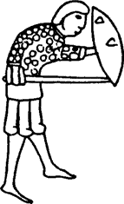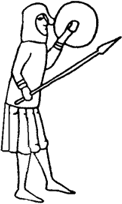 On Early Period Persona: The Colour of Fightingby Sir Andras Salamandra
On Early Period Persona: The Colour of Fightingby Sir Andras Salamandra
 On Early Period Persona: The Colour of Fightingby Sir Andras Salamandra On Early Period Persona: The Colour of Fightingby Sir Andras Salamandra |
 Heroic Warrior Culture: Bare your breast to your opponent to show that your are un-armored and not afraid of your opponent. Hide your armor under loose-fitting tunic & braes, and wear fake hair under the spot tunic. Pull the tunic apart in front with a great show of bravado. Probably equally effective for the lady fighters, for somewhat different reasons, although I suggest leaving off the chest hair.
Some cultures had "hero's feats". Learn and perform them to fill your hapless opponent with awe and fear. The Irish, in particular, had quite a list of them. Since all we know of most or them is their names, it gives us quite a bit of latitude in re-creating them. For example: the salmon feat, which probably involved some kind of leaping into the air, or the "apple" feat, which may have involved throwing apples into the air and impaling them on your spear or sword.
Get a bard to sing your praises before the battle. This is great if you can get a bard for each side to praise their warriors. Examples are the biblical David and Goliath pre-fight entertainment and the wonderful scene from the movie "Alfred the Great".
Non-Christian Celtic: carry the severed heads of your opponents on your belt. Point out to your opponent that the man you already slew was twice the warrior you now face. For additional fun, although I can't document it, throw them at your opponents in the next melee. I make mine out of Styrofoam heads (wig stands) covered in beige cloth (glued on) and with hair of flax. I don't dye the flax as I prefer the 'dead Saxon' look.
Scandinavian: Be a berserker: gnaw your shield, foam at the mouth (a piece of Alka-Seltzer under the tongue works great), and cover up the fact that you wear armor.
An early Moslem might give his opponent the chance to convert to the "true religion" before the battle. Traditionally this was done three times just to make sure he had a chance to convert.
Many cultures: don't fail to cast doubts as to the legitimacy or your opponents' lineage! Don't use profanity, instead develop some colorful stock phrases appropriate to your culture. Examples: 'Son of a hundred fathers and parent to none', etc. During a fourteenth century melee one of the warriors asked for a break to quench his thirst. His opponent replied, "Drink thy blood, Beaumanioir, thy thirst will pass!".
Learn to use the distinctive weapons of your culture. Example: if early Frankish, learn to use the 'francisca', the Frankish throwing axe. Use the Celtic center-grip 'peanut' style shield with a short spear or the Norse center-grip round and the Norman axe, etc. Use their names in your propaganda. Look through the sagas and stories of your culture for examples.
There are reports of Germanic tribes sending screaming women, pulling out their own hair, to demoralize their enemies. Perhaps some of your 12-14th lady friends (or yourself., if appropriate) could do likewise. Saracens did something similar, but when under siege by Byzantines.
If you lose, have your people demand 'wergeld' or pay it yourself if you win. Argue about the value of the 'dead' man, consult a bard or judge. Many cultures had complicated tables to decide how much compensation was to be paid. Make or demand your payment in foil covered chocolate coins, junk jewelry or beer. Hold a 'burial ale' on the spot so your friends can drink to your memory and extol virtues. Keep it short enough so that you don't cross the line from being entertaining to being a pain.
Did your people use disciplined battle formations with precision maneuvers (i.e. Byzantines & late Roman holdovers) or did they use a war band formation (i.e., follow the war-leader)? Try their tactics in melee fighting.
If all else fails, learn to die well. In fact, if you get good enough at losing a fight, no one will remember who beat you, they'll only remember how well you fought! There are two main styles to dying, the realistic and the theatrical. You know you are good at realistic deaths when the crowd gasps and the chiurgeons curse your name. A good theatrical death will have the crowd in stitches from your wounds instead of you!
The Norse had a saying: "Cattle die, kinsfolk die and we ourselves die. One thing lives on --a man's reputation." You will be remembered for what you do, so do it well.
Heroic Warrior Culture: Bare your breast to your opponent to show that your are un-armored and not afraid of your opponent. Hide your armor under loose-fitting tunic & braes, and wear fake hair under the spot tunic. Pull the tunic apart in front with a great show of bravado. Probably equally effective for the lady fighters, for somewhat different reasons, although I suggest leaving off the chest hair.
Some cultures had "hero's feats". Learn and perform them to fill your hapless opponent with awe and fear. The Irish, in particular, had quite a list of them. Since all we know of most or them is their names, it gives us quite a bit of latitude in re-creating them. For example: the salmon feat, which probably involved some kind of leaping into the air, or the "apple" feat, which may have involved throwing apples into the air and impaling them on your spear or sword.
Get a bard to sing your praises before the battle. This is great if you can get a bard for each side to praise their warriors. Examples are the biblical David and Goliath pre-fight entertainment and the wonderful scene from the movie "Alfred the Great".
Non-Christian Celtic: carry the severed heads of your opponents on your belt. Point out to your opponent that the man you already slew was twice the warrior you now face. For additional fun, although I can't document it, throw them at your opponents in the next melee. I make mine out of Styrofoam heads (wig stands) covered in beige cloth (glued on) and with hair of flax. I don't dye the flax as I prefer the 'dead Saxon' look.
Scandinavian: Be a berserker: gnaw your shield, foam at the mouth (a piece of Alka-Seltzer under the tongue works great), and cover up the fact that you wear armor.
An early Moslem might give his opponent the chance to convert to the "true religion" before the battle. Traditionally this was done three times just to make sure he had a chance to convert.
Many cultures: don't fail to cast doubts as to the legitimacy or your opponents' lineage! Don't use profanity, instead develop some colorful stock phrases appropriate to your culture. Examples: 'Son of a hundred fathers and parent to none', etc. During a fourteenth century melee one of the warriors asked for a break to quench his thirst. His opponent replied, "Drink thy blood, Beaumanioir, thy thirst will pass!".
Learn to use the distinctive weapons of your culture. Example: if early Frankish, learn to use the 'francisca', the Frankish throwing axe. Use the Celtic center-grip 'peanut' style shield with a short spear or the Norse center-grip round and the Norman axe, etc. Use their names in your propaganda. Look through the sagas and stories of your culture for examples.
There are reports of Germanic tribes sending screaming women, pulling out their own hair, to demoralize their enemies. Perhaps some of your 12-14th lady friends (or yourself., if appropriate) could do likewise. Saracens did something similar, but when under siege by Byzantines.
If you lose, have your people demand 'wergeld' or pay it yourself if you win. Argue about the value of the 'dead' man, consult a bard or judge. Many cultures had complicated tables to decide how much compensation was to be paid. Make or demand your payment in foil covered chocolate coins, junk jewelry or beer. Hold a 'burial ale' on the spot so your friends can drink to your memory and extol virtues. Keep it short enough so that you don't cross the line from being entertaining to being a pain.
Did your people use disciplined battle formations with precision maneuvers (i.e. Byzantines & late Roman holdovers) or did they use a war band formation (i.e., follow the war-leader)? Try their tactics in melee fighting.
If all else fails, learn to die well. In fact, if you get good enough at losing a fight, no one will remember who beat you, they'll only remember how well you fought! There are two main styles to dying, the realistic and the theatrical. You know you are good at realistic deaths when the crowd gasps and the chiurgeons curse your name. A good theatrical death will have the crowd in stitches from your wounds instead of you!
The Norse had a saying: "Cattle die, kinsfolk die and we ourselves die. One thing lives on --a man's reputation." You will be remembered for what you do, so do it well.
